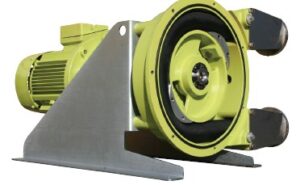The peristaltic pump is also known as a hose pump in the industry, and it can sometimes be referred to as a dosing pump or a metering pump. Essentially, peristaltic pumps are a type of positive displacement pumps.
These pumps are capable of pumping different types of liquids. On the other hand, it can be used safely in many points from chemical transfers to wastewater treatment.
The drive system and cylinders come to the fore in the working order of peristaltic pumps, which have a unique design and are functionally preferred. As a result of the rotation of the rollers, a vacuum is created in the system where the flexible hose is compressed.
The flexible hose is the only part that comes into contact with the fluid in this process. Therefore, this situation provides a serious convenience in terms of use. It is also possible to talk about frequency inverter controlled or variator controlled models for fixed speed pumps or variable flow needs.
Working Principle and Features of Peristaltic Pump
Peristaltic pumps are divided into different types in terms of structure. The design and functional features of each pump may differ from each other. In qualified pump types, the effect of wear is relatively reduced.
This is largely due to the rotational motion achieved in the oil. Peristaltic pump types can perform at different capacities and pressures. Likewise, the price situation changes in parallel with these features.
In the working principle, the compression of the fluid is at the focal point. As a result of this compression, the fluid can move easily. It is used relatively more in the transfer processes of corrosive liquids. A rotor is actively supported in the system. Materials such as gaskets or valves are not used in these special pumps.

This greatly reduces maintenance costs. On the other hand, peristaltic pumps also have important advantages in terms of sterilization. The hose and rotor are the main backbone of the system.
The Usage Area of Peristaltic Pumps
The rotor is located in the middle of the pump. In general, there are circular movements in the system. The cylinder does not leak after the movement in the system.
When the usage areas of peristaltic pumps are examined, we can say that they are distributed in many different sectors today. Food processing, mining, paper industry, pharmaceutical industry, chemical measurement, chlorination, dosing are among the sectors in which peristaltic pumps are used.
As the system became closely known and tried, it began to find a place for itself in much wider parts of the industry. The role of the advantages it provides and its reasonable costs in its use in such a wide area are great.
The fact that it works even at very high pressure values and has a self-priming system is one of these advantages. France-based Albin has been producing hose type pumps for the dosing of mud, corrosive chemicals, abrasive, shear sensitive liquids, fluids containing solid
particles or high viscosity and density with high precision (± 1%) since 1928.
Albin Hose pumps are positive displacement and 9 m. It has the ability to self-suction up to a depth (90% vacuum). They are the first choice in many demanding applications, as they do not require regular maintenance, are reliable in continuous operation, and can be used without leakage, clogging or abrasion problems as a result of the transferred fluid only being in contact with the hose.
With different models and combinations, they can be used with capacities ranging from 15 lt/hour dosing applications to 150 m3/hour transfer applications, and pressures up to a maximum of 15 bar.
Advantages:
Albin Hose pumps supply very good results especially in the transfer of abrasive, corrosive, sensitive and viscous liquids that are prone to fragmentation.
• It can self-priming from a depth of 9 meters.
• Since the hoses consist of 2 to 6 polyamide layers, their lifespan is quite long.
• The electric motor is completely independent of the pump mechanism, so that the transferred liquid does not come into contact with the motor.
• When maintenance is required, it can be easily performed in the field and in the application area.
• As a result, there are easy and low-cost operation and maintenance expenses.
• Precise and continuous dosing can be done.
• Dry running does not cause any problems, it can run dry all the time.
• Since it can work in two directions, it is easy to open the clogged suction lines or empty the lines.
• It can operate at high pressure between 0 - 15 bar.
• It has easy maintenance, the consumable is only the hose.
• There are no high risk materials such as check valve, seal, diaphragm, rotor etc. in its structure.

Usage Areas:
• Water and Wastewater Treatment Facilities: Wastewater and sludge applications, lime sludge, carbide, foam, sodium hypochlorite, iron chloride etc. transfers Filterpress applications.
• Paper Industry: Paints, sizing and holding aids, bentonite, starch, calcium carbonate, glue and titanium dioxide transfer.
• Food Industry: All kinds of waste, molasses, wine, beer, dairy products, sweeteners and additives, sugar syrup, etc. transfers and dosage.
• Textile Industry: Dyes, fibers, acids, wastewater and sludge applications.
• Chemical Industry: Transfer and dosage of corrosive acids and bases.
• Paint Industry: Pigment, latex, paint, ink etc. transfers, dispersion feeding.
• For all kinds of transfer and dosage needs in mining, mineral processing, ceramics, agriculture, construction, machinery manufacturing and many more sectors.
Kadir Fakioğlu
Industrial Division Sales Manager
Sisdoz A.Ş.

 This greatly reduces maintenance costs. On the other hand, peristaltic pumps also have important advantages in terms of sterilization. The hose and rotor are the main backbone of the system.
This greatly reduces maintenance costs. On the other hand, peristaltic pumps also have important advantages in terms of sterilization. The hose and rotor are the main backbone of the system.
